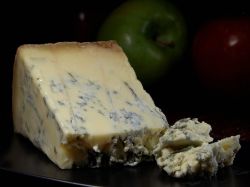In-depth understanding of the status of blue cheese and gluten
Recent blog posts and news articles have posted a quote from Shelley Case, stating that according to a Canadian Celiac Association study, blue cheese (or bleu cheese) is gluten-free. It is important to look more in-depth at the study that she was referring to, what it means, and exactly how the tests were conducted.
To make blue cheese, cheese makers place cultured mold into tiny holes in a round of cheese. Historically, blue cheese was made using bread as the base to grow the mold. It is the mold that grows in and on the cheese, giving it the blue/green veins. The bread was simply the food for the mold, and the the mold was transplanted to the cheese. The question has been whether or not the bread could contaminate the cheese with gluten.
Most commercial cheese makers use chemical starters now, instead of bread, to grow the mold. This is easier to control, more predictable, and cheaper. Some cheese makers still use a bread starter to grow the mold.
The CCA study looked at the fact that if bread is used for a starter base, the mold feeds off of the protein (gluten) and uses it to multiply, breaking down the gluten in the fermentation process (p4, pp4). To determine the amount of gluten, if any, carried over in the process, the team sent 5 samples to Dr. Terry Koerner’s lab in the Food Research Division at Health Canada. Three of the samples were blue cheese samples that were made using mold grown on bread, and 2 of the samples were mold samples grown on wheat-based dextrose.
The lab used three different tests; R-Biopharm ELISA test, Tepnel ELISA, and R-Biopharm Competitive ELISA test. The R-Biopharm ELISA (enzyme-linked immunosorbent assay) test has a detection limit of 1.5 parts per million, or ppm, meaning the test will indicate a negative result if the quantity of gluten is below 1.5 parts per million. The Tepnel ELISA test has a detection limit of 1 ppm. The R-Biopharm Competitive ELISA tests is used to detect gluten protein fragments.
The blue cheeses used for the testing were St. Benoit Blue Cheese, Roquefort Blue Cheese, and Alexis de Portneuf Blue Cheese. All three of the blue cheeses were made using mold grown on gluten-containing bread, but all three showed no detectable levels of gluten using the three different ELISA tests. The molds grown on the wheat-dextrose also showed no detectable levels of gluten. This means that if there was any gluten carried over through the fermentation process, the gluten molecules were less than 1 part per million (the Tepnel test detection level).
How much is 1 part per million? 1 drop of water per 50 liters, or 13.2 gallons, according to Learner.org. The European Codex revised their definition of gluten-free from 500 ppm to no more than 20 ppm in July 2008. According to the Celiac Sprue Association of America, there is currently a proposed FDA definition of gluten-free that would limit the gluten in products sold in the United States to 20 ppm or less.
Since the blue cheeses tested were all measured to have “below detectable levels” (ie. less than 1 part per million) of gluten, and they specifically tested blue cheeses that used gluten-containing grains as a starter, then it does appear safe to say that blue cheese is gluten-free.
Shelly Case, B.Sc., R.D., was quoted,
“The Canadian Celiac Association (CCA) has recently investigated a variety of blue cheese on the market and found that very few are made using bread mold, and when they are, the test results completed by Health Canada found no detectable levels of gluten in the final product. The new CCA Acceptability of Food and Food Ingredients for the Gluten-Free Diet pocket dictionary lists blue cheese as allowed on a gluten-free diet.”
Please note: Just because blue cheese is gluten-free that doesn’t mean that blue cheese salad dressing is gluten-free. Read the ingredient label and contact the manufacturer to be sure. Salad dressing ingredients can still include gluten-containing ingredients.
For more info: Read the the full Canadian Celiac Association article, from March 2009.
See how blue cheese is made, and how to make it at home.
View the CSA article comparing the Codex, CSA, and proposed FDA gluten-free definitions.
Visit the FDA page for more information about the proposed gluten-free definition.













Leave your response!